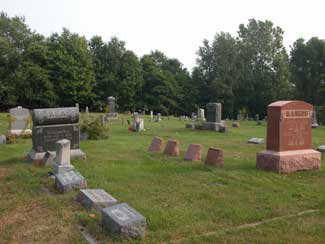Main Content
Article
Cemetery & Burial Registry
 Location information and survey data on each cemetery and burial ground in the state is being gathered and entered into the DHPA's Cemetery and Burial Ground Registry. The Division has the mandate of recording all Hoosier cemeteries and burial grounds, not just "historic" cemeteries. To manage the vast amount of information being collected, the DHPA has created a searchable database.
Location information and survey data on each cemetery and burial ground in the state is being gathered and entered into the DHPA's Cemetery and Burial Ground Registry. The Division has the mandate of recording all Hoosier cemeteries and burial grounds, not just "historic" cemeteries. To manage the vast amount of information being collected, the DHPA has created a searchable database.
DHPA Staff is working with volunteers from local historical societies, genealogy associations, and other interested groups to create preliminary lists of cemeteries within each county, locate and visit cemeteries, and complete a survey form for each site. Researchers can use deeds, newspapers, and mortuary records to locate cemeteries that are no longer marked and visible. Archaeological research and evidence can also be used to find sites. As each county list is compiled, cemeteries are visited and documented using special inventory forms. The survey form records the cemetery's location, the number of grave markers, a general assessment of the cemetery's condition, ethnic and/or religious affiliations, special groups represented such as veterans, and architectural features such as wrought iron fences, statuary, mausoleums, and formal landscape designs. Because there are about 100,000 cemeteries and burial grounds in Indiana, it is not possible at this time to document each grave marker, inscription, and name.
Once a cemetery's information is gathered, volunteers and staff map the site and enter the information into the database. Future goals for the project include making the database accessible on the Internet. The data will be linked with a geographic information system (GIS) to generate maps showing the location of cemeteries.
This project also assists with the enforcement of state legislation intended to protect cemeteries from development pressures. State law (IC 14-21-1-26.5) requires that any person planning to disturb the ground within 100 feet of a burial ground or cemetery for the purpose of erecting, altering, or repairing a structure must submit a development plan to the DHPA. This law does not prohibit construction near a cemetery (once the development plan is approved by the DHPA), nor does it prohibit moving cemeteries if the proper permits are acquired. This law only requires that developers' plans take into account cemetery locations. The database will be a tool that developers and builders can use to determine if their planned activities will affect a cemetery or burial site in the vicinity of their project.
The Cemetery and Burial Ground Registry Staff conducts a number of public education and outreach programs. Publications, workshops, and presentations are intended to increase the public's understanding of cemeteries, prehistoric burial grounds, and the need to preserve these sacred places. This project will ensure that the cemeteries in use today do not become the lost and forgotten cemeteries of tomorrow. The DHPA encourages and welcomes public involvement in this program to help preserve these important pieces of our cultural heritage.
